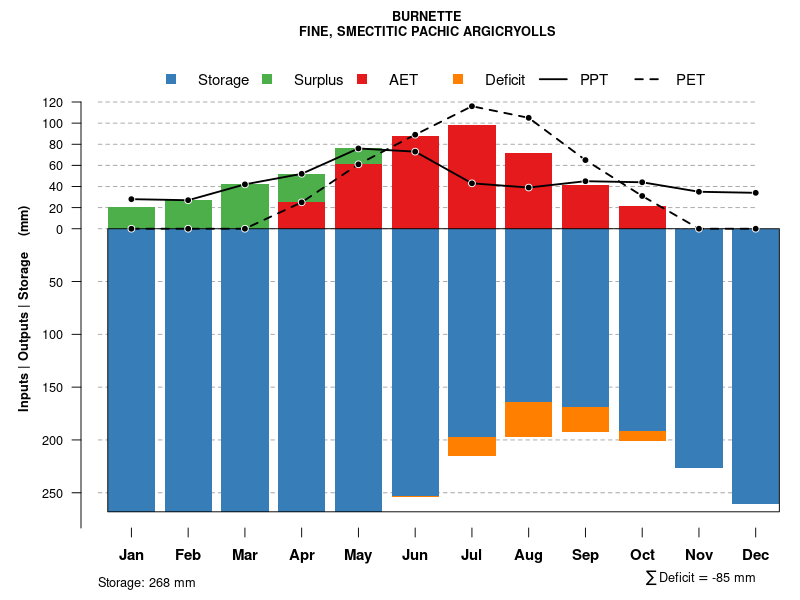| Owen Creek-Jerry-Burnette complex, 5 to 35 percent slopes | 83 | 4253 | 496929 | jp2z | co684 | 1984 | 1:24000 |
Burnette clay loam, 3 to 40 percent slopes | 11 | 1337 | 496833 | jnzw | co684 | 1984 | 1:24000 |
Owen Creek-Jerry-Burnette loams, 5 to 35 percent slopes | 57 | 26846 | 497009 | jp5k | co685 | 1979 | 1:24000 |
Bachus-Burnette family-Ticanot, very stony surface, complex, 15 to 50 percent slopes | 838 | 10691 | 2733448 | 2slrk | id713 | | 1:24000 |
Bachus-Burnette family-Ticanot, very stony surface, complex, 15 to 50 percent slopes | 838 | 187 | 3163437 | 2slrk | id716 | | 1:24000 |
Bachus-Burnette family-Ticanot, very stony surface, complex, 15 to 50 percent slopes | 838 | 512 | 2858645 | 2slrk | id758 | 1998 | 1:24000 |
Burnette-Burnette variant silty clay loams, 8 to 15 percent slopes | 36 | 2870 | 342535 | chfj | mt027 | 1979 | 1:24000 |
Burnette-Burnette variant silty clay loams, 2 to 8 percent slopes | 35 | 1982 | 342534 | chfh | mt027 | 1979 | 1:24000 |
Burnette silty clay loam, 2 to 8 percent slopes | 34 | 581 | 342533 | chfg | mt027 | 1979 | 1:24000 |
Burnette stony loam, hilly | BP | 20110 | 146770 | 4xqj | mt600 | 1969 | 1:24000 |
Doby-Burnette complex, hilly | DH | 5538 | 146794 | 4xr9 | mt600 | 1969 | 1:24000 |
Burnette-Adel association, rolling | BW | 4554 | 146771 | 4xqk | mt600 | 1969 | 1:24000 |
Nettleton-Burnette association, undulating | NB | 2962 | 146895 | 4xvk | mt600 | 1969 | 1:24000 |
Burnette loam, undulating | Bu | 651 | 146783 | 4xqy | mt600 | 1969 | 1:24000 |
Elispring-Skaggs-Burnette families, complex, 2 to 15 percent slopes | 1155D | 829 | 3039671 | 2qbzg | mt602 | 1963 | 1:20000 |
Burnette-Doolittle complex, 4 to 15 percent slopes | 956D | 840 | 2598008 | 2pgb6 | mt605 | 2007 | 1:24000 |
Burnette-Doolittle complex, 15 to 35 percent slopes | 956E | 268 | 2598009 | 2pgb7 | mt605 | 2007 | 1:24000 |
Tiban, extremely bouldery-Rooset, very stony-Burnette complex, 8 to 45 percent slopes, landslides | 815F | 89 | 2496290 | 2pdjq | mt605 | 2007 | 1:24000 |
Burnette-Adel complex, 15 to 50 percent slopes, landslides | 738F | 2749 | 2515384 | 2ppjf | mt612 | 2011 | 1:24000 |
Knep, stony-Philipsburg-Burnette complex, 8 to 35 percent slopes, landslides | 749E | 2647 | 2485014 | 2pdvr | mt612 | 2011 | 1:24000 |
Burnette-Rooset-Maciver, very stony complex, 4 to 35 percent slopes, landslides | 814E | 1397 | 2484748 | 2pdl5 | mt612 | 2011 | 1:24000 |
Tiban, extremely bouldery-Rooset, very stony-Burnette complex, 8 to 45 percent slopes, landslides | 815F | 921 | 2484703 | 2pdjq | mt612 | 2011 | 1:24000 |
Cowcoulee-Burnette family-Herakle family, stony, complex, 8 to 35 percent slopes | 1156E | 928 | 3039722 | 2qbzh | mt613 | 1975 | 1:24000 |
Elispring-Skaggs-Burnette families, complex, 2 to 15 percent slopes | 1155D | 286 | 3039721 | 2qbzg | mt613 | 1975 | 1:24000 |
Burnette-Rooset-Maciver, very stony complex, 4 to 35 percent slopes, landslides | 814E | 3195 | 2492963 | 2pdl5 | mt614 | 2012 | 1:24000 |
Burnette-Doolittle complex, 15 to 35 percent slopes | 956E | 1547 | 2486424 | 2pgb7 | mt614 | 2012 | 1:24000 |
Tiban, extremely bouldery-Rooset, very stony-Burnette complex, 8 to 45 percent slopes, landslides | 815F | 855 | 2520747 | 2pdjq | mt614 | 2012 | 1:24000 |
Burnette-Doolittle complex, 4 to 15 percent slopes | 956D | 855 | 2486423 | 2pgb6 | mt614 | 2012 | 1:24000 |
Knep, stony-Philipsburg-Burnette complex, 8 to 35 percent slopes, landslides | 749E | 17 | 2541636 | 2pdvr | mt614 | 2012 | 1:24000 |
Burnette-Adel complex, 15 to 50 percent slopes, landslides | 738F | 6 | 2541649 | 2ppjf | mt614 | 2012 | 1:24000 |
Cowcoulee-Burnette family-Herakle family, stony, complex, 8 to 35 percent slopes | 1156E | 6973 | 2632237 | 2qbzh | mt632 | | 1:24000 |
Elispring-Skaggs-Burnette families, complex, 2 to 15 percent slopes | 1155D | 5176 | 2632236 | 2qbzg | mt632 | | 1:24000 |
Gaylord-Burnette complex, 4 to 15 percent slopes | 48 | 3182 | 146472 | 4xdx | mt636 | 1983 | 1:24000 |
Cowcoulee-Burnette family-Herakle family, stony, complex, 8 to 35 percent slopes | 1156E | 149 | 2979657 | 2qbzh | mt637 | 2014 | 1:24000 |
Adel-Burnette-Bynum complex, 4 to 35 percent slopes | 294E | 3943 | 348547 | cppg | mt657 | 1990 | 1:24000 |
Adel-Burnette-Sebud complex, 4 to 35 percent slopes | 394E | 856 | 348618 | cprr | mt657 | 1990 | 1:24000 |
Burnette-Lucky Star association | 10 | 15311 | 152053 | 536y | wy043 | 1976 | 1:24000 |
Clayburn-Wallrock association | 13 | 5834 | 152056 | 5371 | wy043 | 1976 | 1:24000 |
Burnette-Lucky Star association | 10 | 1223 | 816471 | wdls | wy619 | 1971 | 1:24000 |
Clayburn-Wallrock association | 13 | 81 | 816474 | wdlw | wy619 | 1971 | 1:24000 |
Bachus-Burnette family-Ticanot, very stony surface, complex, 15 to 50 percent slopes | 838 | 743 | 2858664 | 2slrk | wy623 | 1971 | 1:20000 |
Burnette loam, 3 to 10 percent slopes | 126D | 146 | 157923 | 59b9 | wy656 | 2008 | 1:24000 |
Groomer-Foxton-Burnette families, complex, 0 to 15 percent slopes | 171 | 198 | 151951 | 533n | wy663 | 2012 | 1:24000 |
Burnette loam, 3 to 10 percent slopes | 126 | 2374 | 502991 | jwdj | wy713 | 1986 | 1:24000 |














